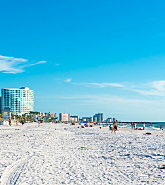“We believe that natural ecosystems protect against catastrophic coastal flood losses, but how can we prove it?”
This question was the start of a conversation in 2014 which has led to some interesting results. And it set us thinking: can RMS’ models, like the one which estimates the risk of surge caused by hurricanes, capture the protective effect of those natural ecosystems?
The conversation took place at a meeting on Coastal Defenses organized by the Science for Nature and People Partnership. RMS had been invited by one of our leading clients, Guy Carpenter, to join them. The partnership is organized by The Nature Conservancy, the Wildlife Conservation Society, and the National Center for Ecological Analysis and Synthesis.
We were confident we could help. Not only did we think our models would show how biological systems can limit flood impacts, we reckoned we could measure this and then quantify those benefits for people who calculate risk costs, and set insurance prices.
RMS’ modeling methodology uses a time-stepping simulation, which relies on a specialist ocean atmosphere model, allowing us to evaluate at fine resolution how the coastal landscape can actually reduce the storm surge—and in particular lower the height of waves. In many buildings the real weakness proves to be the vulnerability to wave action rather than just the damage done by the water inundation alone.
The first phase of RMS’ work with The Nature Conservancy is focused on coastal marshes as part of a project supported by a Lloyd’s Tercentenary Research Foundation grant to TNC and UC Santa Cruz. Under the supervision of Paul Wilson, in the RMS model development team, and working with Mike Beck who’s the lead marine scientist for The Nature Conservancy, the project is focused on the coastlines, which were worst impacted by the surge from Superstorm Sandy. The irregular terrain of the marsh and resulting frictional effects reduce the surge height from the storm. Our work is showing that coastal marshes can reduce the flood risk costs of properties, which lie inland of the marshes by something in the range of 10-25%.
Tropical Defenses
So, that’s the effect of coastal marshes. But what about other biological defenses such as mangrove forests and offshore reefs (whether coral or oyster reefs)? Further research is planned in 2016 using RMS models to measure those likely benefits too.
But here’s a rather intriguing (if unscientific) thought: is there a curious Gaia-like principle of self-protection operating here in that the most effective natural coastal protections—mangroves and coral reefs—are themselves restricted to the tropics and subtropics, the very regions where tropical cyclone storm surges pose the greatest threat? Mangroves cannot withstand frosts and therefore in their natural habitat only extend as far north along the Florida peninsula as Cape Canaveral. And yet in our shortsightedness humans have removed those very natural features, which could help protect us.
Paradise Lost?
Between 1943 and 1970 half a million acres of Florida mangroves were cleared to make way for smooth beaches—those beautiful and inviting stretches of pristine sand which have for decades attracted developers to build beachfront properties. Yet, paradoxically, that photogenic “nakedness” of sand and sea may be one of the things, which leaves those properties most exposed to the elements.
With the backing of The Nature Conservancy it seems mangroves are making a comeback. In Miami-Dade County they’re examining a planting program to protect a large water treatment facility. Of course biological systems can only reduce part of the flood risk. They can weaken the destructive storm surge but the water still gets inland. To manage this might require designing buildings with water-resistant walls and floors, or could involve a hybrid of grey (manmade) and green defenses. And if we can reduce the destructive wave action, that might allow us to build earth embankments protected with turf in place of expensive and ugly, but wave-resistant, concrete flood walls.
On March 28, 2015 The Nature Conservancy organized a conference and press briefing in Miami at which they announced their collaboration with RMS to measure the benefits of natural coastal defenses. The coastline of Miami-Dade, already experiencing the effects of rising high tide sea levels, presents real opportunities to test out ways of combatting hurricane hazards and stronger storms through biological systems. Our continued work with The Nature Conservancy is intended to develop metrics that are widely trusted and can eventually be adopted for setting flood insurance prices in the National Flood Insurance Program.






